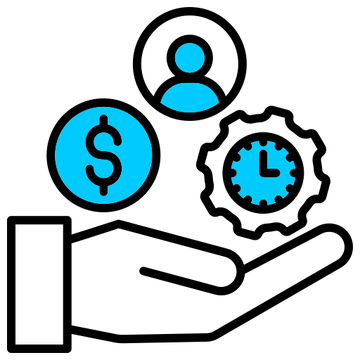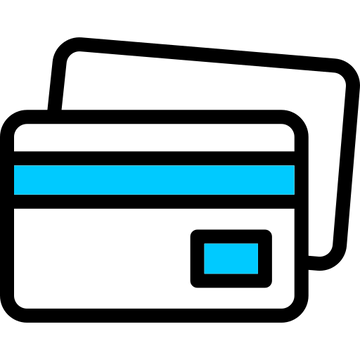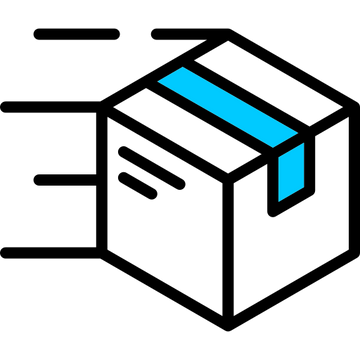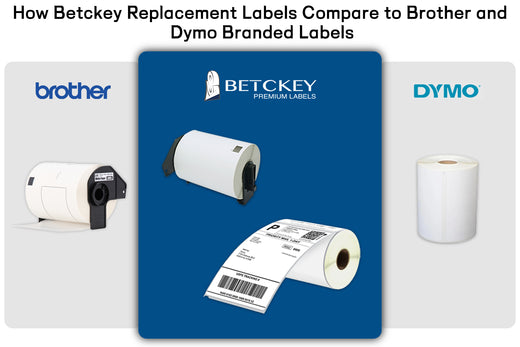

Removable Film Labels
Written by: Beichen Lu
|
|
Time to read 6 min
Thanks to all our supporters, Betckey has become one of the leading suppliers providing replacement labels compatible with Brother and Dymo printers. This year, we are continuing to grow even beyond our expectations. Many new and existing customers still ask us what the differences are between Betckey replacement labels and Brother or Dymo branded labels. In this blog, we will discuss how Betckey replacement labels perform compared to branded labels in terms of thickness, price, adhesive quality, and customer friendliness.
Table of Content
First of all, we admit that Betckey labels are 15% thinner than Brother and Dymo branded labels in general. Check out the comparison chart below. The general thickness, including both the back paper and label (facestock + adhesive), of Betckey, Brother, and Dymo labels are 0.125mm, 0.148mm, and 0.155mm, respectively. Betckey labels are 15% thinner than branded labels.
For the backing paper, the data for the three brands are 0.050mm, 0.058mm, and 0.057mm, which don't show much difference. But the label part data are 0.075mm, 0.090mm, and 0.098mm, mainly caused by the facestock (excluding adhesive).
With the 15% thinner disadvantage, Betckey labels are less competitive in terms of scratch resistance and durability compared to branded labels. However, this doesn’t necessarily mean Betckey’s technology is worse because making labels thinner is harder than making them thicker. Thinner labels are more likely to break during the waste-discharge process during manufacture.
But why does Betckey intend to use a more complicated procedure to produce thinner labels? The answer is cost-effectiveness.
If you are a heavy user of direct thermal labels, you must have experienced difficulty sourcing special sizes like 4" x 12". On one hand, most direct thermal sellers catering to customers don’t offer these sizes due to low demand. On the other hand, you might not be able to meet the minimum order quantity for size customization.
However, Brother labels come to the rescue with their auto-cut printer and continuous labels. But who will cut the labels when you print content at your designed size? No need to manually cut them because Brother printers with their auto-cut feature will do it for you.
For labels, once they reach a certain thickness or durability, the thicker they become, the lower the return. This phenomenon is known as the Law of Diminishing Marginal Utility. In terms of investment, it implies that as consumption increases, the additional utility gained from each extra unit decreases. In simpler terms, once a certain level is reached, more effort yields less gain. Consider the analogy of eating ice cream: after consuming a certain amount, each additional scoop brings less happiness. This principle applies to manufacturing as well.
In label production, a thickness of 0.125mm is already durable enough to withstand normal wear and tear during package handling and shipping. Labels may sustain damage in very rare situations, such as intentional scratching with a knife. While it's possible to increase durability by 15% by paying at least 15% more, this enhancement may still not withstand intentional scratches like those from a knife. Do customers really want to pay a 15% higher price for each roll if it still can't handle rare and extreme cases?
Another advantage of Betckey labels is their perforation, distinguishing them from Dymo branded labels. Brother printers feature an "auto-cut" function, eliminating the need for perforation to separate labels. However, Dymo labels lack this feature.
Unlike Dymo branded labels, which do not have perforation on all their label sizes, Betckey replacement labels include perforation on all sizes to assist users in easily separating labels when needed."
The third advantage of Betckey replacement labels is the "No-glue Design" on the last label in a roll to avoid printer jams. Unlike all other brands, including Brother and Dymo branded labels, which use hot-melt adhesive to stick the last label in the roll, Betckey uses rotary force to make the last label "adhere" to the roll without hot-melt adhesive.
When using hot-melt adhesive, the adhesive may still be active when users print the last label, leaving residue that can cause the printer to jam. However, rotary force presents a different scenario. There is no residue on the core, so printers will not jam.
Why Hot-melt Adhesive May Cause Jams
(1) The hot-melt adhesive may not have expired due to certain circumstances. This can result in the last label being unable to detach, rendering it unusable and causing wastage of resources and environmental impact.
(2) Even if the hot-melt adhesive has expired when in use, it forms adhesive residue. When users use it, the residue can get stuck on the thermal sensitive head of the thermal printer, causing damage to the thermal sensitive head or even the entire printer.is can result in issues like printer jam, causing losses and waste.
The last advantage of Betckey replacement labels is compatibility. Many of you know that there are two printer versions for Brother and Dymo branded labels: North American and International. Brother branded labels don’t have much difference between them, but Dymo labels do. For the North American version, Dymo labels only need index holes on the back paper to be identified by Dymo North American version printers. But for International version labels, there are both index holes and black sensor marks on the back paper because Dymo International version printers use two sensors to identify labels.
However, Betckey includes both index holes and black sensor marks in both market inventories so users are able to use labels compatible with their printer, whether North American version or International version. Do North American users or International users own printers that are not their market version? Yes!
Due to the exclusivity of Dymo's new generation 550 series and 5XL series that require RFID chips, all third-party labels and even Dymo's elder batch labels are not compatible with the new printers. So, many users shop for pre-owned 450 series and 4XL series printers online. And it is very common to receive a printer that is not their market version.
Unlike Dymo branded labels, Betckey replacement labels are compatible with both North American version and International version printers.
One difference between Betckey replacement labels and branded labels is adhesive. One of the most significant features for evaluating adhesive is temperature range. We all know that storage temperature and operating temperature are totally different, but I couldn’t find reliable resources regarding the operating temperature of the two branded labels, so we can only compare storage temperatures.
The Betckey replacement labels have a storage temperature range of -80°C to 80°C, which is identical to Brother branded labels. Dymo branded labels have a storage temperature range of -65°F to 200°F, which equals -62°C to 93.3°C. In other words, both Betckey replacement labels adhesive and Brother branded labels adhesive have better low-temperature reliability, Yet Dymo branded labels’ adhesive is better in extreme heat.
Compared to Brother and Dymo branded labels, Betckey replacement labels have advantages in cost-effectiveness, perforation, “No-glue” design, and compatibility. However, there is a drawback in storage temperature. The disadvantage of Betckey replacement labels is that they are 15% thinner than branded labels. But there is a trade-off for more thickness. Are customers really willing to pay a 15% higher price for more durability that they hardly use?
If so, then it’s time for Betckey to build a new high-end brand that provides exact or even better quality than branded labels.
If you want to buy thermal labels or sticker paper, you can check out more on our store
Products Featured In This Blog

24/7 support team

Multiple Payment Methods

Worry-free shopping

Delivery in 3-7 business days
Be the first to know about label discounts,
product launches, and time-saving tips — subscribe now!
Are you 18 years old or older?
Sorry, the content of this store can't be seen by a younger audience. Come back when you're older.
They are exactly what I need, very easy to use!!!
Everithing was really good, fast delivery, product quality 100% guarantee
Very versatile label for mailing addresses and a marketing to promote a product or get someone’s attention.
Brother DK-2205 Compatible Continuous Labels 2.4" x 100'
Great little labels to use in pricing jewelry. Saves a lot time when you use with a thermal printer. I use on the hang tags and other display cards. Will definitely reorder in the future.
The label is perfect it's very recommended to everyone
iLabel 4x6 Thermal Shipping Label Printer Bluetooth Wireless
Dymo 30256 Removable Film Waterproof Shipping Labels 2-5/16” x 4”









